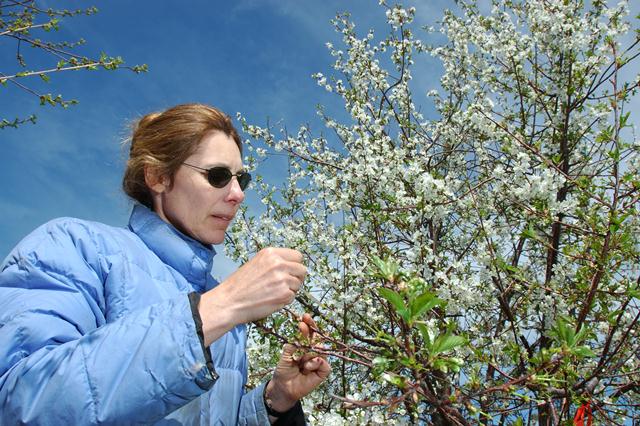Perfecting Michigan cherries
How Spartan research supports the state’s renowned tart cherry industry
Some Spartan researchers have cherries on their minds year-round and for good reason. Michigan is the country’s top producer of tart cherries and Michigan State University has been part of the industry’s growth for decades.
“Michigan State University researchers are leaders in cherry research to support this industry, including on production strategies and disease and insect control,” says MSU’s Amy Iezzoni, the nation’s only tart cherry breeder.
Amy Iezzoni
In 2019, Iezzoni was named Innovator of the Year by the MSU Innovation Center for her work to develop cherry rootstocks that reduce the size of sweet cherry trees by 65-75%.
Putting Michigan on the map
According to the USDA, Michigan produces on average 187 million pounds of tart cherries each year, or about 68% of the tart cherries produced in the entire country.
Iezzoni conducts genetic research with both sweet and tart cherries.
“Sweet cherries are firmer and are most often eaten fresh,” says Iezzoni, a professor in the Department of Horticulture in the College of Agriculture and Natural Resources, and a member of MSU’s Plant Breeding, Genetics and Biotechnology program. “Tart cherries have a more acidic profile for baking, especially pies, jams, juice and wine along with dried cherries.”
Visitors and residents of Michigan will recognize the distinctive tart flavor in many of the cherry food and beverage products sold in the state, especially if they’ve visited the National Cherry Festival in Traverse City, an annual event that draws hundreds of thousands from around the world.
Breeding “cherry red”
Iezzoni’s research focus has made her a leader in the field of cherry genetics. The bright fire-engine red color of the Montmorency tart cherry is recognized widely as the perfect shade of tart cherry red.
“To achieve this color, we found a region on the cherry genome that has a (specific) gene that controls this color,” Iezzoni says.
Thanks to recent advances in cherry genomics, Iezzoni’s team could scan the cherry genome to look for this major red color gene. Variants of this gene now are used to preselect breeding materials with the desirable fruit color, thereby increasing the efficiency of the breeding program.
Supporting growers
Recently, Michigan’s cherry industry has faced multiple challenges across a wide range of disciplines such as managing pests and diseases, reducing or eliminating cherry pits, identifying the best ways to protect against frost damage and dealing with pressure from imported cherries coming from other countries, primarily Turkey. MSU researchers are focused on many of these to help the industry overcoming these obstacles.
“When the cherry industry has a challenge, I investigate whether I can help fix the problem,” says Iezzoni. “The spotted wing drosophila (fly), a new invasive insect, will lay eggs in almost any red berry, so breeding for resistance is not an option. But after talking with MSU entomologists, we figured out that if I could breed cherries that would ripen and be harvested earlier, before the flies were present in large numbers, growers would save significantly on the costs of trying to control this insect.”
Iezzoni has been breeding cherries at MSU for more than 30 years. Helping Michigan growers has been a high point of her career.
“I hope to do my part to help keep the cherry industry profitable and sustainable through my research.”
